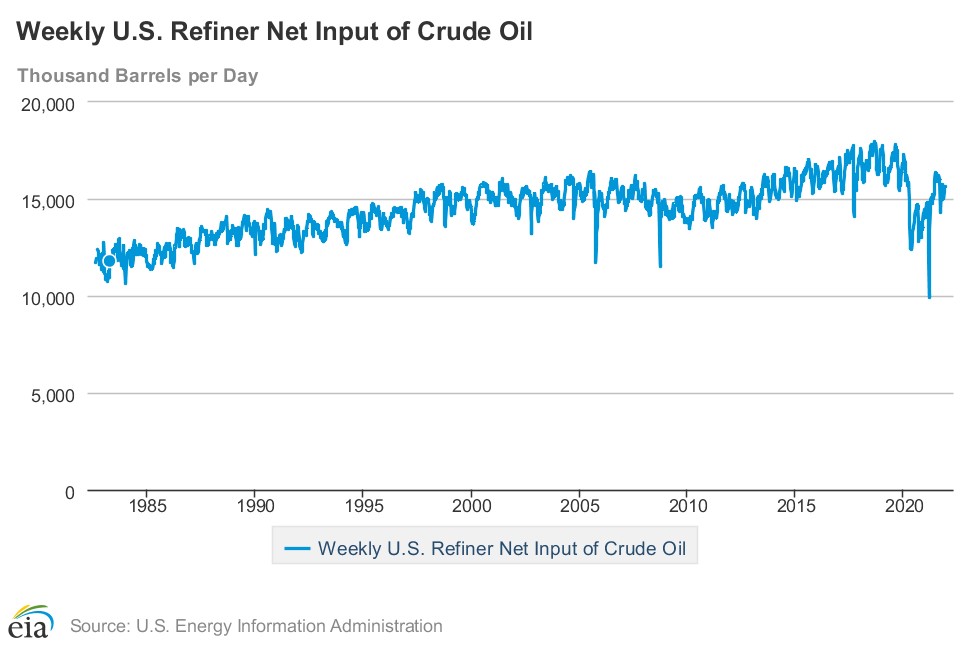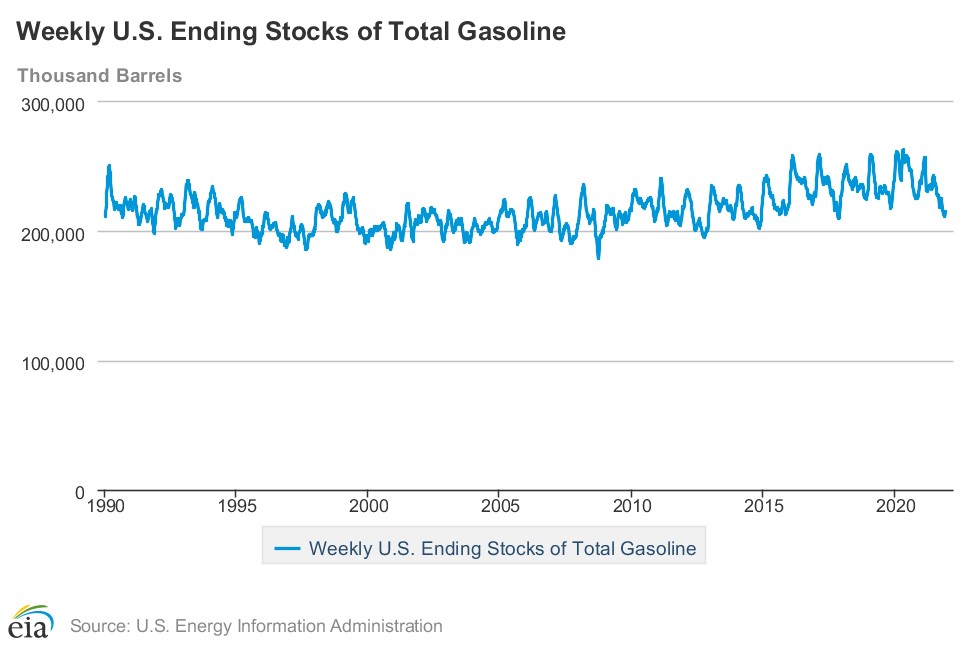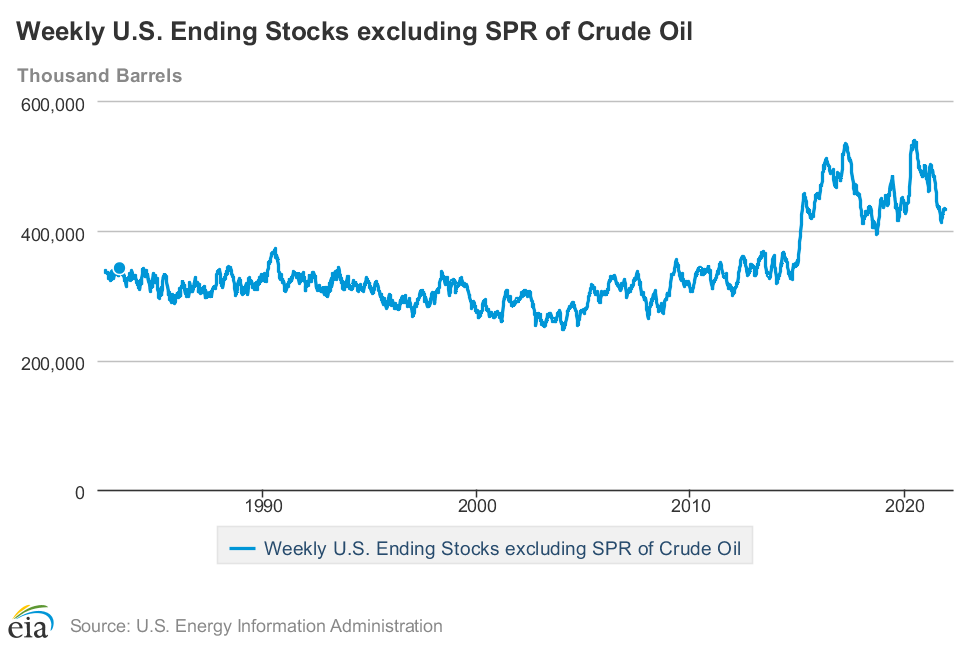Blogger RJS, Focus on Fracking, Strategic Petroleum Reserve is at an 18 1/2 Year Low; Gasoline Supplies Rose by Most in 22 Weeks on a 22 Week Low in Demand The Latest US Oil Supply and Disposition Data from the EIA Weekly U.S. Ending Stocks excluding SPR of Crude Oil (Thousand Barrels) (eia.gov) US oil data from the US Energy Information Administration for the week ending November 26th showed that after a switch of “unaccounted for crude oil” from the supply side to the demand side, we needed to pull oil out of our stored commercial crude supplies for the third time in ten weeks and for the twenty-third time in the past thirty-five weeks….our imports of crude oil rose by an average of 168,000 barrels per day to an average of 6,604,000 barrels
Topics:
run75441 considers the following as important: Focus on Fracking, RJS, US/Global Economics
This could be interesting, too:
Joel Eissenberg writes How Tesla makes money
Angry Bear writes True pricing: effects on competition
Angry Bear writes The paradox of economic competition
Angry Bear writes USMAC Exempts Certain Items Coming out of Mexico and Canada
Blogger RJS, Focus on Fracking, Strategic Petroleum Reserve is at an 18 1/2 Year Low; Gasoline Supplies Rose by Most in 22 Weeks on a 22 Week Low in Demand
The Latest US Oil Supply and Disposition Data from the EIA
US oil data from the US Energy Information Administration for the week ending November 26th showed that after a switch of “unaccounted for crude oil” from the supply side to the demand side, we needed to pull oil out of our stored commercial crude supplies for the third time in ten weeks and for the twenty-third time in the past thirty-five weeks….our imports of crude oil rose by an average of 168,000 barrels per day to an average of 6,604,000 barrels per day, after rising by an average of 245,000 barrels per day during the prior week, while our exports of crude oil rose by an average of 99,000 barrels per day to an average of 2,704,000 barrels per day during the week, which together meant that our effective trade in oil worked out to a net import average of 3,900,000 barrels of per day during the week ending November 26th, 69,000 more barrels per day than the net of our imports minus our exports during the prior week…over the same period, production of crude oil from US wells was reportedly 100,000 barrels per day higher at 11,600,000 barrels per day, and hence our daily supply of oil from the net of our international trade in oil and from domestic well production appears to have totaled an average of 15,500,000 barrels per day during the cited reporting week…
Meanwhile, US oil refineries reported they were processing an average of 15,631,000 barrels of crude per day during the week ending November 26th, an average of 9,000 fewer barrels per day than the amount of oil they processed during the prior week, while over the same period the EIA’s surveys indicated that a net of 408,000 barrels of oil per day were being pulled out the supplies of oil stored in the US….so based on that reported & estimated data, this week’s crude oil figures from the EIA appear to indicate that our total working supply of oil from net imports, from storage, and from oilfield production was 277,000 barrels per day more than what our oil refineries reported they used during the week…to account for that disparity between the apparent supply of oil and the apparent disposition of it, the EIA just plunked a (-277,000) barrel per day figure onto line 13 of the weekly U.S. Petroleum Balance Sheet to make the reported data for the daily supply of oil and the consumption of it balance out, essentially a balance sheet fudge factor that they label in their footnotes as “unaccounted for crude oil”, thus suggesting there must have been a error or omission of that magnitude in this week’s oil supply & demand figures that we have just transcribed…and since last week’s EIA fudge factor was at (+220,000) barrels per day, that means there was a 497,000 barrel per day difference in the EIA’s crude oil balance sheet error from a week ago, and hence the week over week supply and demand changes indicated by this week’s report are fairly useless…however, since most everyone treats these weekly EIA reports as gospel and since these figures often drive oil pricing, and hence decisions to drill or complete oil wells, we’ll continue to report this data just as it’s published, and just as it’s watched & believed to be reasonably accurate by most everyone in the industry…(for more on how this weekly oil data is gathered, and the possible reasons for that “unaccounted for” oil, see this EIA explainer)….
This week’s 408,000 barrel per day net decrease in our crude oil inventories came as 130,000 barrels per day were pulled out of our commercially available stocks of crude oil, while 278,000 barrels per day of oil were pulled out of our Strategic Petroleum Reserve, possibly still part of an emergency loan of oil to Exxon in the wake of hurricane Ida…including the drawdowns from the Strategic Petroleum Reserve under such emergency programs, a total of 51,920,000 barrels per day have been removed from the Strategic Petroleum Reserve for a series of other “emergencies” over the past 16 months, and as a result the amount of oil in our Strategic Petroleum Reserve has fallen to an 18 1/2 year low of 602,556,000 barrels per day, as repeated tapping of our emergency supplies for political expediency or to “pay for” other programs have already drained those supplies over the past dozen years…with the BIden administration’s announcement last week that another 50 million barrels of oil will be released to incentivize continued use of American gas guzzlers, we have initiated weekly coverage of the SPR storage status on this blog…
Further details from the weekly Petroleum Status Report (pdf) indicate that the 4 week average of our oil imports rose to an average of 6,335,000 barrels per day last week, which was 18.5% more than the 5,345,000 barrel per day average that we were importing over the same four-week period last year….this week’s crude oil production was reported to be 100,000 barrels per day higher at 11,600,000 barrels per day even though the EIA’s rounded estimate of the output from wells in the lower 48 states was unchanged at 11,100,000 barrels per day, because a 5,000 barrel per day increase in Alaska’s oil production to 454,000 barrels per day added 100,000 barrels per day to the reported rounded national production total (EIA math)…US crude oil production had hit a pre-pandemic record high of 13,100,000 barrels per day during the week ending March 13th 2020, so this week’s reported oil production figure was still 11.5% below that of our pre-pandemic production peak, but 37.6% above the interim low of 8,428,000 barrels per day that US oil production had fallen to during the last week of June of 2016…
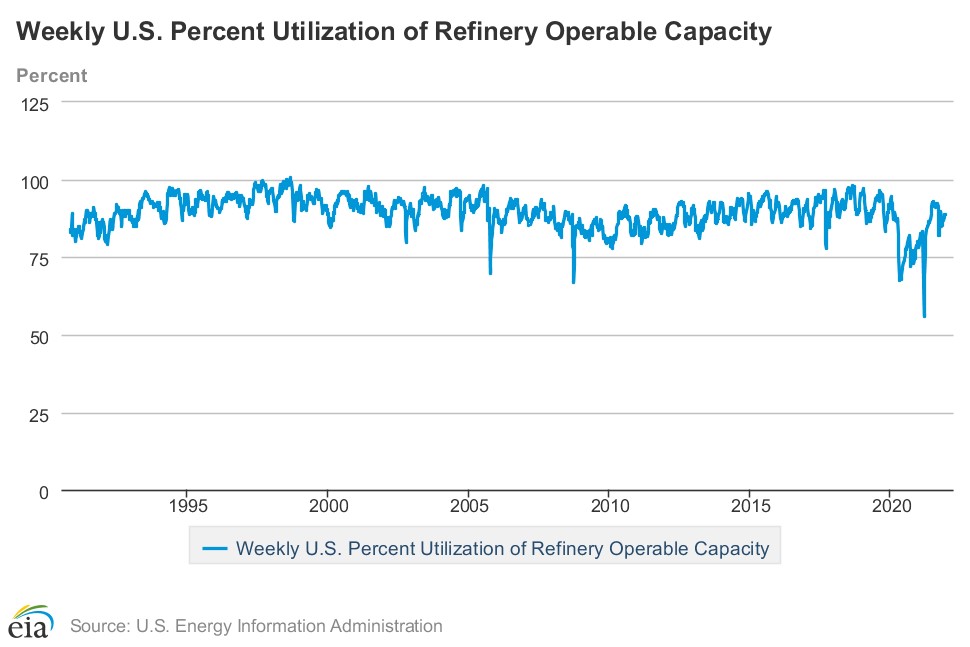
US oil refineries were operating at 88.8% of their capacity while using those 15,631,000 barrels of crude per day during the week ending November 26th, up from 88.6% of capacity the prior week, but still a bit below normal utilization for late-autumn refinery operations…the 15,631,000 barrels per day of oil that were refined this week were 11.6% more barrels than the 14,012,000 barrels of crude that were being processed daily during the pandemic impacted week ending November 27th of last year, but 6.9% less than the 16,798,000 barrels of crude that were being processed daily during the week ending November 29th, 2019, when US refineries were operating at what was then a close to normal 91.9% of capacity…
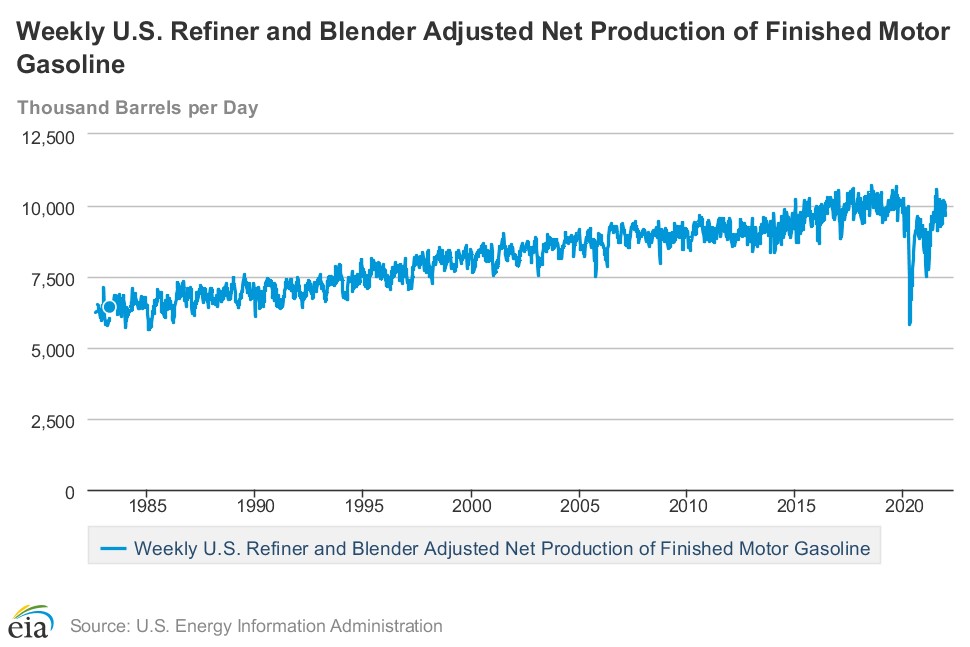
Even with the amount of oil being refined little changed this week, the gasoline output from our refineries was quite a bit lower, decreasing by 450,000 barrels per day to9,649,000 barrels per day during the week ending November 26th, after our gasoline output had increased by 177,000 barrels per day over the prior week.…this week’s gasoline production was still 12.4% more than the 8,584,000 barrels of gasoline that were being produced daily over the same week of last year, but 2.9% less than the gasoline production of 9,941,000 barrels per day during the week ending November 29th, 2019….on the other hand, our refineries’ production of distillate fuels (diesel fuel and heat oil) increased by 88,000 barrels per day to 4,872,000 barrels per day, after our distillates output had decreased by 58,000 barrels per day over the prior week…with that increase, our distillates output was 6.2% more than the 4,587,000 barrels of distillates that were being produced daily during the week ending November 27th, 2020, but 7.4% less than the 5,263,000 barrels of distillates that were being produced daily during the week ending November 29th, 2019..
Even with the big drop in our gasoline production, our supplies of gasoline in storage at the end of the week rose for the first time in eight weeks, and for the thirteenth time in thirty-two weeks, rising by 4,029,000 to 215,422,000 barrels during the week ending November 26th, after our gasoline inventories had decreased by 603,000 barrels to a 48 month low over the prior week…our gasoline supplies increased this week because the amount of gasoline supplied to US users decreased by 538,000 barrels per day to a 22 week low of 8,796,000 barrels per day, and because our imports of gasoline rose by 160,000 barrels per day to 643,000 barrels per day, while our exports of gasoline rose by 279,000 barrels per day to 887,000 barrels per day…even after this week’s big inventory increase, our gasoline supplies were 7.8% lower than last November 27th’s gasoline inventories of 233,638,000 barrels, and about 5% below the five year average of our gasoline supplies for this time of the year…
With the increase in our distillates production, our supplies of distillate fuels increased for the third time in fourteen weeks and for the 11th time in 34 weeks, rising by 2,160,000 barrels to 123,877,000 barrels during the week ending November 26th, after our distillates supplies had decreased by 1,968,000 barrels to a 23 month low during the prior week….our distillates supplies rose this week because the amount of distillates supplied to US markets, an indicator of our domestic demand, fell by 182,000 barrels per day to 4,209,000 barrels per day, and because our exports of distillatesfell by 419,000 barrels per day to 588,000 barrels per day, while our imports of distillates fell by 98,000 barrels per day to 234,000 barrels per day….but after twenty-three inventory decreases over the past thirty-four weeks, our distillate supplies at the end of the week were 15.1% below the 145,870,000 barrels of distillates that we had in storage on November 27th, 2020, and about 9% below the five year average of distillates stocks for this time of the year…
Meanwhile, in addtion to this week’s withdrawal of oil from our Strategic Petroleum Reserve, our commercial supplies of crude oil in storage also fell for the 17th time in the past twenty-seven-weeks and for the 33rd time in the past year, decreasing by 909,000 barrels over the week, from 434,020,000 barrels on November 19th to 433,111,000 barrels on November 26th, after our commercial crude supplies had increased by 1,017,000 barrels over the prior week…after this week’s decrease, our commercial crude oil inventories slipped to around 6% below the most recent five-year average of crude oil supplies for this time of year, but were still 24.9% above the average of our crude oil stocks as of the last weekend of November over the 5 years at the beginning of the past decade, with the disparity between those comparisons arising because it wasn’t until early 2015 that our oil inventories first topped 400 million barrels….since our crude oil inventories had jumped to record highs during the Covid lockdowns of last spring and remained elevated for most of the year after that, our commercial crude oil supplies as of this November 26th were 11.3% less than the 488,042,000 barrels of oil we had in commercial storage on November 27th of 2020, and are now 3.1% less than the 447,096,000 barrels of oil that we had in storage on November 29th of 2019, and 2.3% less than the 443,162,000 barrels of oil we had in commercial storage on November 30th of 2018…
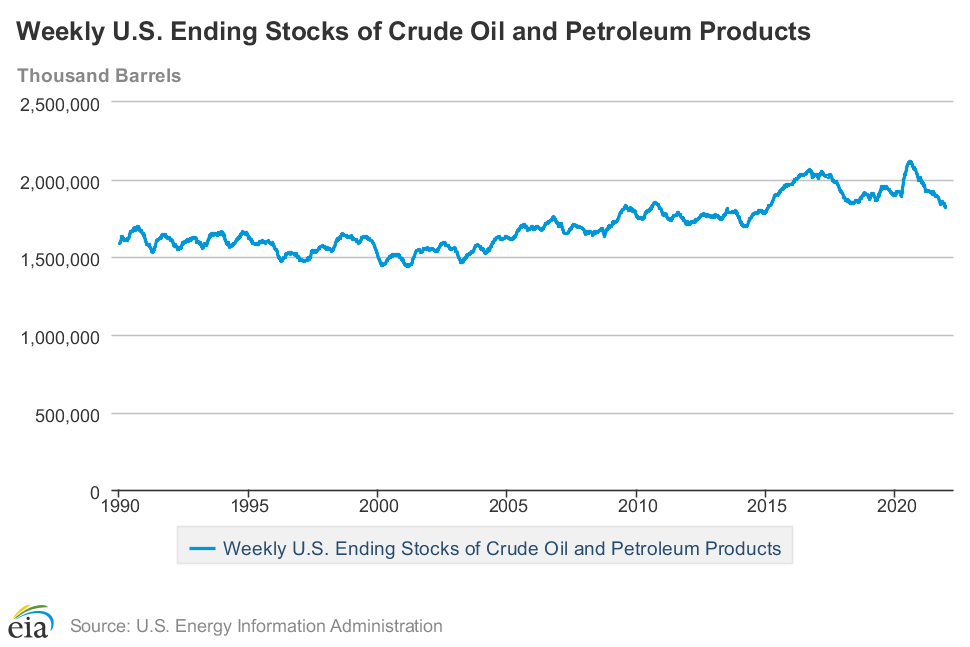
Finally, with our inventory of crude oil and our supplies of all products made from oil all at or near multi year lows, we are continuing to track the total of all U.S. Stocks of Crude Oil and Petroleum Products, including those in the SPR….the EIA’s data shows that total oil and oil product inventories, including those in the Strategic Petroleum Reserve and those held by the oil industry, rose by 2,319,000 barrels this week, from 1,822,392,000 barrels on November 19th to 1,824,711,000 barrels on November 26th, which is still the 2nd lowest level of total US inventories since January 23rd, 2015, just up fractionally from last week’s a 82 month low…


